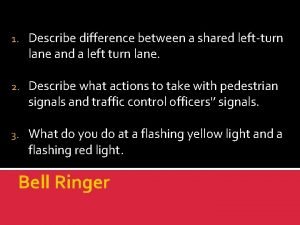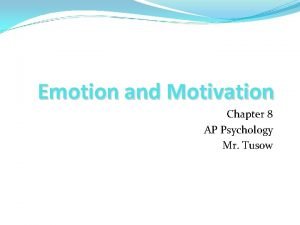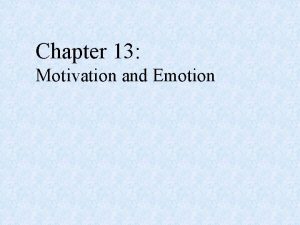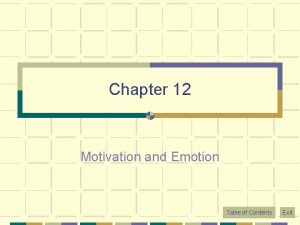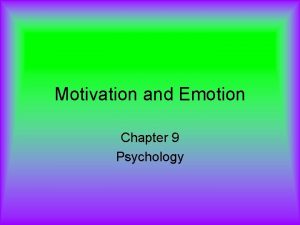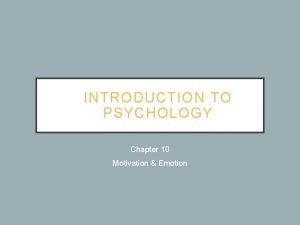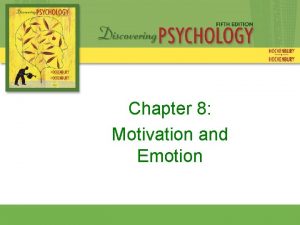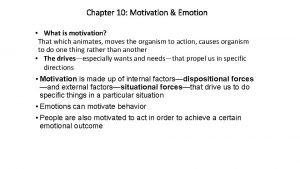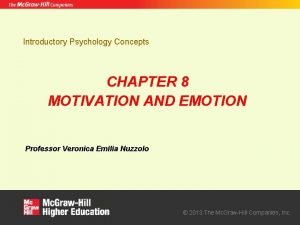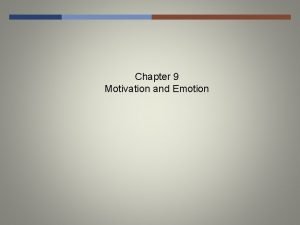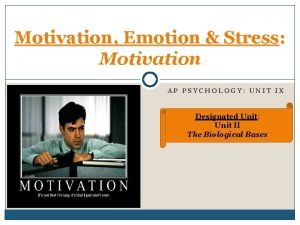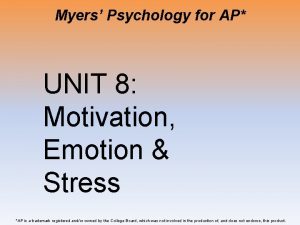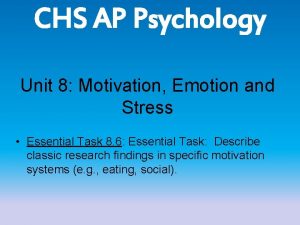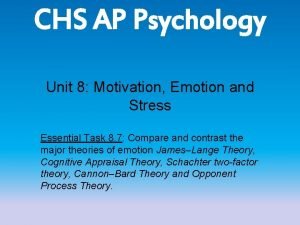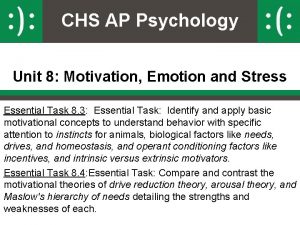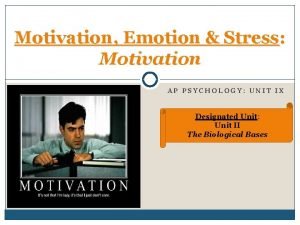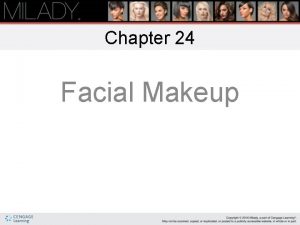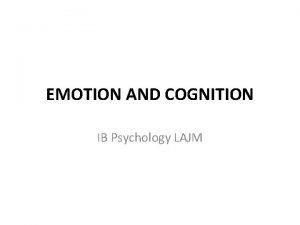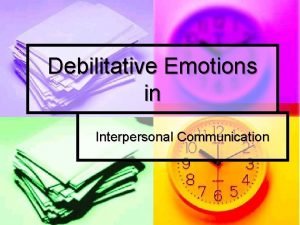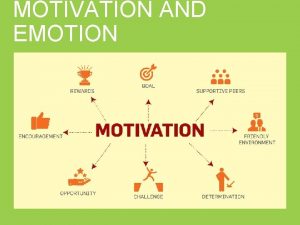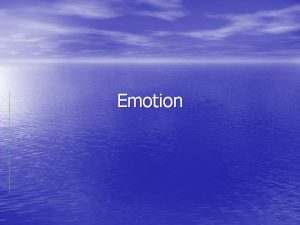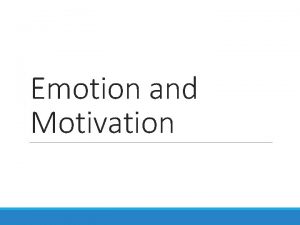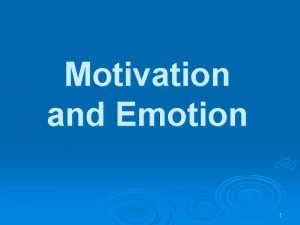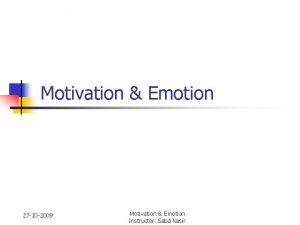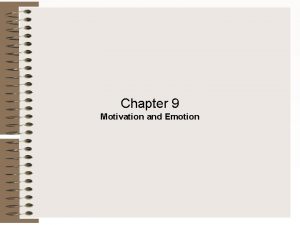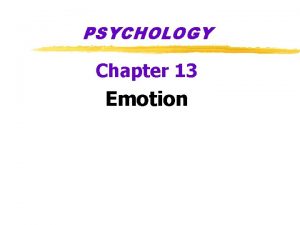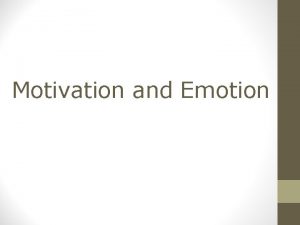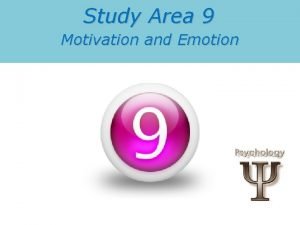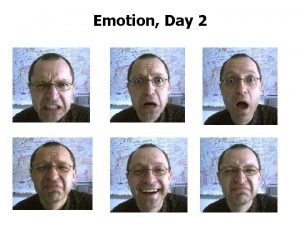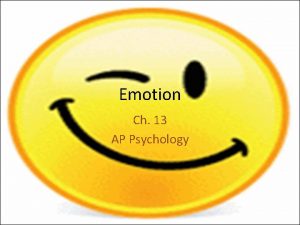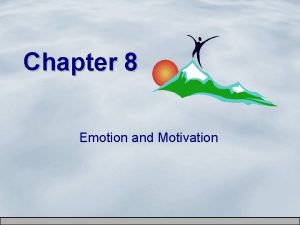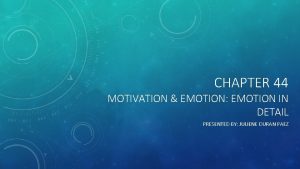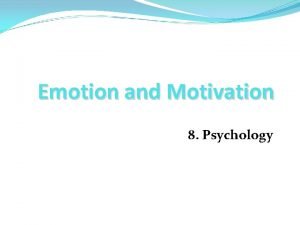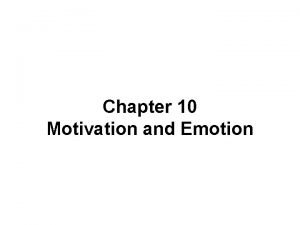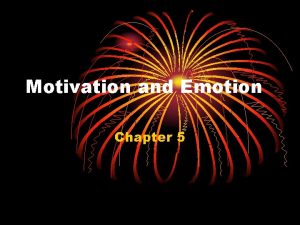Chapter Eight MOTIVATION AND EMOTION Motivation and Emotion




























- Slides: 28

Chapter Eight MOTIVATION AND EMOTION

Motivation and Emotion • Motivation: Biological, emotional, cognitive, or social forces that activate and direct behavior. • Emotion: a psychological state involving subjective experience, physiological response, and behavioral or expressive response.

Motivation and Emotion • There are three basic characteristics commonly associated with motivation: activation, persistence, and intensity. – Activation is demonstrated by initiation or production of behavior. – Intensity is seen in the greater vigor of the response that usually accompanies motivated behavior. – Persistence is demonstrated by continued efforts or determination to achieve a particular goal.

Motivational Concepts and Theories Instinct Theories • People are motivated to engage in certain behaviors because of evolutionary programming. • In the 1920 s, instinct theories had fallen out of favor as an explanation of human motivation, primarily because of the theories lacked explanatory power. Sharon King Grimm • The general idea that human behaviors are innate and genetically influenced did remain important.

James’s List of Human Instincts Attachment Resentment Fear Curiosity Disgust Shyness Rivalry Sociability Greediness Bashfulness Suspicion Secretiveness Hunting Cleanliness Play Modesty Shame Love Anger Parental Love

Arousal Theory: Sensation Seeking • The optimal level of arousal varies from person to person; it is especially evident in sensation seekers, who find the heightened arousal of novel experiences very pleasurable. Sensation Seeking: Extreme Skiing • People who rank high on the dimension of sensation seeking have a need for varied, complex, and unique sensory experiences.

Hunger and Eating Terms to Learn Hunger: Biological motive Eating behavior: Complex interaction of biological, social, and psychological factors Glucose: Simple sugar that provides energy and is primarily produced by the conversion of carbohydrates and fats; commonly called blood sugar. Insulin: Hormone produced by the pancreas that regulates blood levels of glucose and eating behavior Basal metabolic rate (BMR): The rate at which the body, when it is at rest, uses energy for vital functions, such as heartbeat and respiration Baseline body weight: Cluster of genetic and environmental factors that cause a person’s weight to settle within a given range

Delicious or Disgusting? • The need to eat is a universal human motive. However, culture influences what we eat, when we eat, and how we eat. Would you order grasshoppers or caterpillars for lunch? • High in protein and readily available, insects are standard fare in many countries.

Energy Homeostasis CALORIES CONSUMED = CALORIES EXPENDED Food is broken down by enzymes, absorbed by intestines. Glucose, or blood sugar, is converted as a source of energy. When your caloric intake exceeds the amount of calories expended for energy, you experience positive energy balance. When you diet or fast, a negative energy balance occurs. Insulin helps control glucose and regulates eating and weight.

Physiological Signals That Regulate Eating • Slight drop in blood glucose • Slight increase in insulin— 30 minutes before eating • Appetite stimulation from hormone ghrelin • Hormone is manufactured in stomach lining • Stimulates secretion of growth hormone by pituitary gland in brain • Stimulates appetite • Blood levels of ghrelin rise sharply before and fall abruptly after meals

Excess Weight and Obesity • Prevalence – More than two-thirds of American adults and almost onethird of children are above their healthy weight. – Worldwide, one and a half billion adults are overweight. – Percentage of overweight people increases throughout adulthood, peaking in fifth and sixth decades of life. • Healthy weight determined by – Body mass index (BMI): Numerical scale indicating height in relation to weight – Obesity: Condition characterized by excessive body fat and a BMI equal to or greater than 30. 0 – Overweight: Condition characterized by BMI between 25. 0 and 29. 9

Factors Involved in Becoming Overweight • Multiple factors affect how much people eat and how the calories are metabolized. – – – – “Supersize It” syndrome: overeating Positive incentive value: highly palatable foods Cafeteria diet effect: more choice, more consumed Basal metabolic rate (BMR) Sedentary lifestyle Too little sleep Individual differences and lifespan changes

Factors Involved in Obesity: Interaction of Genetics and Environment • People with a family history of obesity are two to three times more likely to become obese than people with no such family history. • Obesity also occurs in about 30 percent of children with parents who are of normal weight. • High-risk environment for obesity and metabolic factors (leptin resistance) after obesity influence ongoing risk.

Dopamine Receptors and Obesity: Role of Pleasure in Eating and Obesity • Landmark study finds that obese individuals in the study had significantly fewer dopamine receptors than the normal-weight individuals. – Among obese people in the study, the number of dopamine receptors decreased as BMI increased (Wang and colleagues). – People ate more to compensate for reduced brain rewards; overeating reduced the dopamine reward system levels even further; vicious circle ensues.

Can overeating lead to brain changes in humans? • Stice and colleagues: f. MRI research – Response of overweight women to milkshake consumption was related to amount of weight gain between trials. – Implication is that people eat more to compensate for reduced brain rewards. Obesity can be a vicious circle!

Human Sexuality • Multiple factors are involved in understanding human sexuality. – Psychologists consider the drive to have sex a basic human motive. How accurate are media images of human sexuality? Sexual themes and images are often used to sell products, market movies, and boost TV ratings.

Human Sexuality: The Stages of Human Sexual Response • Masters and Johnson’s findings indicated that the human sexual response could be described as a cycle with four stages. • Critics thought their research had violated “sacred ground” and dehumanized sexuality. • However, Masters and Johnson were also praised for advancing the understanding of human sexuality and dispelling misconceptions. Masters and Johnson observed hundreds of individuals engaged in more than 10, 000 episodes of sexual activity in their laboratory.

Human Sexuality: Stages of Human Sexual Response Stage 1: Excitement the beginning of sexual arousal; preparation for intercourse Stage 2: Plateau physical arousal builds Stage 3: Orgasm third and shortest phase of the sexual response cycle • Subjective experience of orgasm is similar in men and women—and very positive • Males ejaculate, females experience vaginal contractions Stage 4: Resolution arousal slowly subsides and returns to normal levels

The Male and Female Sexual Response Cycles The figure on the left depicts the three basic variations of the female sexual response.

Sexual Orientation: The Elusive Search for an Explanation • According to the most recent estimates, about 7% of women and 5% of men report having engaged in homosexual behavior at some point. – – – Sexual orientation Heterosexual Homosexual Gay Lesbian Bisexual

What Determines Sexual Orientation? Genetics: A close degree of genetic relationship is predictive of homosexuality. Prenatal environment: The more older brothers a man has, the more likely he is to be homosexual. Brain structure: Differences are found in the hypothalamus and amygdala of homosexual and heterosexual men

What Determines Sexual Orientation? Other findings • Homosexuality was not a result of disturbed or abnormal family relationships. • Sexual orientation is determined before adolescence and before beginning of sexual activity. • Sexual orientation may be established as early as age 6. • Once orientation is established, whether heterosexual or homosexual, it is highly resistant to change. • Homosexuality is no longer considered a sexual disorder by clinical psychologists or psychiatrists (American Psychiatric Association).

Maslow’s Hierarchy of Needs

Motivation and Culture Individualistic cultures focus on personal, individual success, rather than on a group’s success; is closely linked to success in competitive tasks. Collectivistic cultures’ orientation is toward social harmony and promoting one’s group and/or family.

Emotion • Emotion – Complex psychological state that involves subjective experience, a physiological response, and a behavioral or expressive response • Mood – Milder emotional state that is more general and pervasive, such as gloominess or contentment The Many Functions of Emotion

Evolutionary Explanation of Emotion • Darwin: Emotions reflect evolutionary adaptations to problems of survival and reproduction; they inform others about our individual states • Today: Emotions aid in solving adaptive problems posed by the environment. – – Fear Anger Love Disgust

Subjective Experience of Emotion • Emotion researchers agree there a limited number of basic emotions and responses. • Each basic emotion represents a sequence of responses that is innate and hard-wired in the brain. • People often experience mixed emotions, in which very different emotions are felt simultaneously or in rapid succession.

Turning Your Goals into Reality • Strategies and suggestions that can help you get motivated, take action, and achieve your goals. – Strengthen sense of self-efficacy – Turn goals into actions – Mentally rehearse and visualize the process
 Plane figures and solid figures
Plane figures and solid figures What are the meanings of the eight shapes and eight colors
What are the meanings of the eight shapes and eight colors Cognitive appraisal psychology definition
Cognitive appraisal psychology definition Chapter 13 motivation and emotion
Chapter 13 motivation and emotion Chapter 12 motivation and emotion
Chapter 12 motivation and emotion Chapter 9 motivation and emotion quiz
Chapter 9 motivation and emotion quiz Paul ekman universal facial expressions
Paul ekman universal facial expressions Appraisal psychology meaning
Appraisal psychology meaning Chapter 10 motivation and emotion
Chapter 10 motivation and emotion Chapter 8 motivation and emotion
Chapter 8 motivation and emotion Incentive theory ap psychology
Incentive theory ap psychology Why are motives described as hypothetical states?
Why are motives described as hypothetical states? Hunger motivation ap psychology
Hunger motivation ap psychology Myers ap psych unit 8 vocab
Myers ap psych unit 8 vocab Ap psychology unit 8 motivation emotion and stress
Ap psychology unit 8 motivation emotion and stress Ap psychology unit 8 motivation and emotion test
Ap psychology unit 8 motivation and emotion test Ap psychology unit 8
Ap psychology unit 8 Unit 8 motivation and emotion
Unit 8 motivation and emotion Alfred kinsey ap psychology
Alfred kinsey ap psychology Chapter 8 of the great gatsby summary
Chapter 8 of the great gatsby summary Main events of chapter 8 lord of the flies
Main events of chapter 8 lord of the flies Energy conservation quick check
Energy conservation quick check What shape has 8 faces 12 edges and 6 vertices
What shape has 8 faces 12 edges and 6 vertices Bell and harts eight causes of conflict
Bell and harts eight causes of conflict List eight types of facial cosmetics and how they are used
List eight types of facial cosmetics and how they are used Ceyx and alcyone summary
Ceyx and alcyone summary Forty and eight
Forty and eight Emotion and cognition ib psychology
Emotion and cognition ib psychology Debilitative emotions
Debilitative emotions

